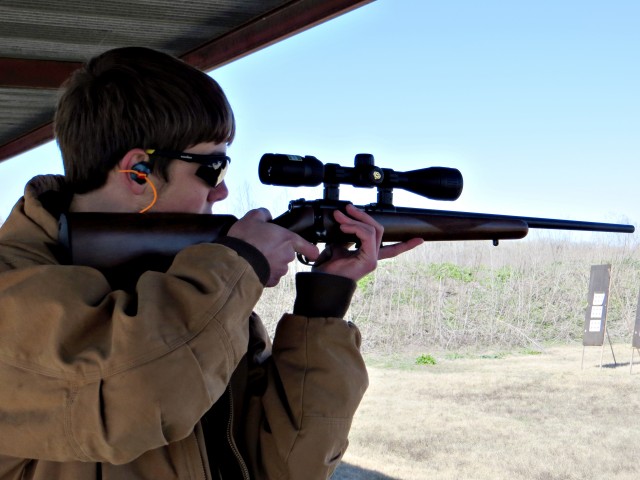Central Texas Debates Gun Training for Children and Teens

James Birgen, a sophomore at Hendrickson High School in Pflugerville, practices silhouette shooting with the Travis County 4H Shooting Sports Club. Photo by Kelsey Jukam.
By Kelsey Jukam
For Reporting Texas
Like many parents who teach their children how to shoot, Derek Bergin wanted his two daughters to learn how to handle firearms safely. A software engineer and volunteer coach for the Gun Club at LBJ High School in Austin, Bergin takes special pride in one of the club’s members: his 16-year-old daughter, Ariana, who holds “expert rifle shooter” certification from the NRA, a feat that requires 88 percent accuracy when shooting at targets from multiple positions.
Bergin knows the inherent dangers firearms pose, he said, but feels the “real tragedy is when something happens because of ignorance. I’m not saying everyone should have a gun in their home, but keeping their children ignorant of things like guns is bad.”
Bergin’s opinion cuts to the heart of the current national debate over how to keep kids safe from gun violence. While some Central Texas parents argue early exposure can foster a healthy respect for guns, others want to keep their children away from firearms entirely.
Dr. Kim Edwards, an Austin pediatrician, who says children and teens are unpredictable around guns because they are curious and impulsive, points to data that suggests a five-fold increase in the risk of suicide in adolescents when there is a gun in their home, “even with the absence of a mental health issue.”
The debate over guns and kids is particularly sharp in a state with a storied gun culture and relatively lenient gun laws, and where the statistics don’t tell a particularly clear story. The Texas Department of State Health Services reported 537 gun-related deaths in children up to 17 years old for the period 2007 to 2011 — a sobering toll that included 60 percent from homicides, 31 percent from suicides, 8 percent from accidents. Nationwide, however, Texas ranks 28th in underage gun fatalities, on par with Delaware at 27 and well behind Alaska at No. 1, according to the Children’s Defense Fund.
Matt Nobles, an assistant professor of criminal justice at Sam Houston State University, says it’s impossible to make a “one-size-fits-all rule” when it comes to deciding whether or how to teach children about gun use. “We regulate … basic use most of the time, and respecting [guns] for safety reasons is appropriate, just like automobiles,” he said. “There is risk involved in both.”
Comprehensive data on firearm-related injuries remains scarce in part because of a 1996 ruling in Congress that limits research by the federally funded Centers for Disease Control and Prevention. In its absence, gun-owning parents in Central Texas tend to remain convinced from personal experience that introducing even young children to firearms is essential to keeping them safe.
“Kids that are … taught gun safety are far less likely to touch a gun when they encounter one, and they also tend to teach other children not to touch it,” said Alan LaFrance, owner of the online community Texas Gun Talk. “They aren’t so inquisitive about dad’s 12-gauge shotgun when it barks two inches of flame out the end and about 150 decibels of noise.”
Rhiannon Vaughn, a senior at Hendrickson High School in Pflugerville, began shooting at age 13. Shooting sports, she believes, are “about teaching kids responsibility, concentration, and teaching the fun.”
Vaughn, the vice president of the Travis County 4-H Shooting Sports club, says the club discourages play with toy guns and forbids shooting at human targets. Members of the club practice at outdoor ranges, shooting at small, metal silhouettes of farm animals or clay “pigeons.”
Gun ranges in Texas allow children of various ages to shoot with adult supervision. Some set the age at 5, some at 10, but most allow parents to use their own discretion. Nobles said he isn’t aware of any specific rationale for setting an age limit, but that physical, mental, and emotional issues should all be considered.
“Shooting a gun is substantially more complex than a simple understanding of right and wrong,” Nobles said. “A shooting environment is loud, distracting, potentially upsetting. Not all children … may have the concentration, focus, patience, and reliance to deal with a stressful situation like that safely and consistently.”
The Brady Campaign to Prevent Gun Violence, a high-profile supporter of increased gun control, has no position on whether kids should shoot guns. Marsha McCartney, president of the Texas chapter of the Brady Campaign to Prevent Gun Violence, said nobody is pushing legislation to set a minimum shooting age.
Meanwhile, people on different sides of the debate can agree that safety is their primary concern. Edwards, who is also the president of the Texas Pediatric Society, says the issue is too complex to focus on one factor such as exposure to firearms. Pediatricians should also talk to parents about safe-storage practices, which she says can reduce the risk of gun injuries among children by 70 percent.
“That’s really the mantra of what I tell my parents,” Edwards said. “It doesn’t have to be a long, drawn-out conversation, and you never want to do it in a judgmental way. Parents are really receptive to that idea, because we know that we are both working for our primary goal which is their child’s health.”